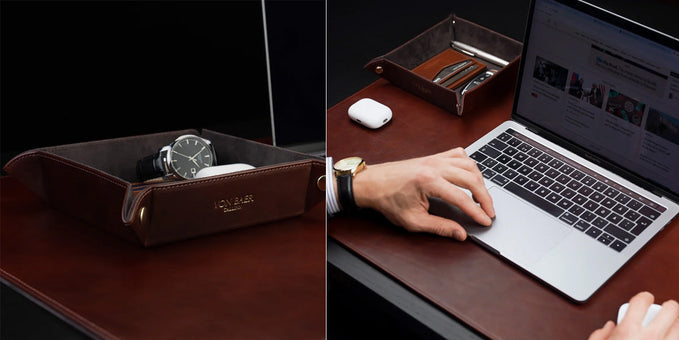Napa leather

Napa leather is sometimes referred to as ‘Nappa leather’ and is famed for its soft feel.
This leather is derived from lambs, calves and kid goats which have soft hides.
This term is a generic one in the leather industry, and it has no special test for characterization.
Napa leather can be used to make products including clothes, car seats, shoes, furniture, and handbags.
The name is taken from the city of Napa in California.
This is where the process of manufacturing Napa leather was first developed by Emanuel Manasse, who was a German tanner working for The Sawyer Tanning Company.
At Von Baer, we only use the highest quality full grain leather in our products.
How is Napa leather made?
What makes Napa leather different from other types of leather is largely its tanning process. Chromium or aluminum sulfate are both salts that are noted for their softness and durability and these are used to tan the hides of Napa leather.
This kind of leather is normally dyed in water-soluble colorants which make it more resistant to fading. The dyeing process also makes Napa leather easier to clean.
Quality
Napa leather is generally a full grain unsplit leather manufactured from kid, lamb, or sheepskin.
Full-grain means that the skin surface hasn’t been modified aside from the removal of hair.
Full-grain leather is often seen as the most authentic kind of leather due to the way that it keeps all of the texture from the original hide. This enables the leather to keep many of its original textures and markings.
The finish process that it undergoes enhances its strength and it is highly regarded for its softness and pliability.
Appearance
Because Napa leather is a chrome-tanned leather, it is very soft and smooth. The natural characteristics of the animal skin are clearly visible. This is due to the way they are not hidden by coatings and paints.
Napa leather is also very sensitive to dirt and bleaching out related to sunlight because the pores are unsealed.
Slightly pigmented Napa leather that’s dyed with water-soluble colorants is also available. This makes the material less vulnerable to abrasion and light. The surface of slightly pigmented can be seen as smoother or more even.
Aniline leather is a kind of Napa leather that is treated with aniline colorants.
Related guides:
- What is Leather
- Faux leather
- Vegan leather
- Bonded vs faux vs real leather
- Bonded leather
- Genuine leather
- Pleather
What kind of products is Napa leather commonly used for?
As Napa leather has a soft, smooth quality it is often used to make car seats. This is because it has what many people call a “buttery soft” seating surface.
Napa leather car seats are regarded as easier to maintain and more durable. They can provide cars with a luxurious, superior styling that’s favored by many car owners.

The product is also used to make furniture upholstery, clothing including jackets and gloves, wallets, briefcases, handbags or purses, shoes, and robust leather items such as holsters or utility belts.
What are the biggest advantages of Napa leather?
Napa leather is very popular when it comes to car seats and other kinds of furniture. It is well-known for its style and elegance as well as its durability. This means it’s only normally found in high-grade vehicles.
Furniture in Napa leather is noted for its incredibly luxurious look and feel. It’s also more straightforward to clean in comparison to fabric.
Dust can easily be wiped off this material. If a spillage occurs, the leather won’t quickly absorb water or liquid. You can clean these by just wiping the surface. It is also hypoallergenic.
What are the disadvantages of Napa leather?
Full-grain Napa leather is regarded to be one of the better varieties when it comes to leather. However, it can be very expensive. You can expect to pay as much as $1000 more for the same kind of vehicle or furniture compared to one with fabric.
It’s also susceptible to damage and discolorations, because it’s a very soft and porous material. This also makes it difficult and pricey to repair.

How do I care for Napa leather?
You will need several supplies to clean Napa leather. Many of these might already be in your home. You’ll need to use a lint-free cloth, a cotton washcloth, a mild dishwashing soap, and a spray leather protectant.
Cleaning supplies you’ll require include a water and stain protectant, leather conditioner and lukewarm water.
You should start caring for your Napa leather just after you purchase it, even before you start to use it. Spray your Napa leather with a water and stain protectant before you use it for the first time. This will help you prevent liquid damage.
It’s essential to apply leather conditioners regularly to keep your Napa leather looking fresh. If you’re using a colored leather polish, ensure that the color of the polish matches the leather.
Don’t use wax-based cleaners or polishes because these can damage your Napa leather. Lanolin-based leather conditioners can help you lock in the color. You will need to apply spray conditioners evenly on the surface. If you use cream leather treatment solutions, remember to use a dampened washcloth to apply the cream evenly. Do not use your fingers.

If you ever need to remove dirt from Napa leather, you can wipe the surface with a dry lint-free cloth. Stains can be gently wiped with a cotton washcloth and lukewarm water. Just dab at the stain carefully and enable the leather to dry. Don’t soak the leather.
Your Napa should be stored in a cool, dry place away from direct sunlight or moisture.
When you can, you can store your bags or shoes in their original boxes. It’s best to hang jackets on wooden hangers with a cotton garment over them.
Clean your leather and apply a spray-on leather protectant before you put your Napa leather away in storage.
Related guides:
- How to reform a leather bag
- How to maintain leather bags
- Repair cracked leather
- Wet leather
- How to clean leather bag
- How to restore faded leather bag
Is Napa leather real leather?
Yes, Napa leather is real leather which either comes from full grain or top grain leather. The only difference is the tanning process. Napa leather can be as strong as full-grain leather due to the way it uses the same layer of animal skin as full-grain.
So, if it is real leather, where does it come from?
Napa leather normally comes from the skins of animals like lambs, calves and kid goats which normally have a more soft, flexible hide as does its end product.
Some Napa leather can be regarded as “genuine leather” depending on where it is sourced from. Genuine leather comes from any layer of animal skin. The animal skin undergoes treatment on its surface. The treatment provides a more uniform and “corrected” appearance.
This treatment typically involves sanding or buffing so any imperfections on the surface can be removed to give the uniform look. The process can also involve dyeing, spray painting, stamping, or embossing to give the leather its final appearance.
Napa leather often comes from full-grain leather. Full grain leather is a premium leather of very high quality. From time to time, you may come across a term like “genuine Nappa leather”, which may confuse you.
However, these are normally marketing statements, and the terms usually mean that the leather is smooth, flexible and soft.
Related guides:
- Top grain leather
- Leather guide for beginners
- What is leather patina
- Vegetable tanned leather
- Leather tanning
- What is artificial leather?
- What is full grain leather
- Where does leather come from
- Mushroom leather
What is the difference between leather and Nappa leather?
There is very little difference between leather and Nappa leather. Leather is a general term which refers to the material or fabric derived from animal skin via the tanning process.
It can refer to the variety of types of leather and the different qualities of the material too. Nappa is a more specific term that is used to describe a specific group of leather options, normally meaning leather which is smooth, soft and flexible.
Generally, leather can have different treatments. Some leather products go through sanding or buffing, and others go through natural and chromium tanning. Nappa leather normally has a natural, high-quality, incorrect grain surface. It goes through chromium tanning but not natural tanning.
To summarize, leather is a general term that can be used to describe various types and qualities, whilst Napa leather is a specific term which describes a specific quality of leather.
Von Baer stock a range of full grain leather products, which you can browse here.
The correct way to spell the name for this kind of leather is with one “p” like Napa, but it has been more common for people to spell it with two over recent years. People will understand what you are referring to regardless of whether you spell it with one “p” or two. Napa is just a way to describe leather and is not the strict meaning of the leather itself. This history of the Napa name begins with the American tribes who roamed and lived before settlers moved in from Europe. There were two tribes in this period, which were the Wappo and Wapin tribes. When the non-natives moved in and started mixing with the locals, they tried to pronounce regional words. Napa is an English way of saying a Native American word which inspired the name of the city Napa, which was founded in 1847 and become Napa, California shortly after. Documents from before California became a state, show the name being spelled with two “p”s. However, the spelling changed to Napa after California’s statehood. Related articles: The man who invented Napa leather was Emanuel Manasse. He was born in Germany and later moved to the US. He was the son of a German leather tanner. It’s thought that he found out about leather from his father. Manasse worked as a leather tanner in New Jersey and was a tanner for the Swayer Tanning Company, founded in 1869. When he moved to Napa, California he continued working as a leather tanner. Manasse developed Napa leather in around 1875. This leather was very soft, flexible, and suitable for making gloves. The leather became known as Napa leather due to the location where it was first developed. This high-quality leather quickly became popular outside of Napa. Manasse became a partner at the Swayer Tanning Company in 1880 and became very wealthy thanks to his invention. Chances are that you will think of leather as well as wine next time Napa comes into your mind. Here’s how to clean napa leather: All leather needs to be conditioned. The process of conditioning Napa leather is no different to conditioning other kinds of leather. Unfinished Nappa leather does need to be conditioned frequently due to its leather fibers which dry out quicker than other forms of leather. Many people say it’s best to condition leather with leather conditioners that come in the form of cream, oil, or wax. You can apply these onto the surface and allow the leather to absorb. This process nourishes and revitalizes the fibers which make up the leather. The process keeps the leather soft and flexible whilst protecting it from scratches. Make sure you clean your leather before you condition it. You can then apply the conditioner with a soft lint-free cloth. The conditioner should be applied in small portions. Make sure you apply it gently in small portions. Leave the conditioner on the leather for a while so the leather can absorb it and wipe off any excess. Once you have conditioned your Napa leather, you can apply a protective finish to further defend it from scratches and water. Just be aware that this can obscure the look and feel of the leather a little. Protective finishes can be natural or come in the form of synthetic fibers and acrylic. This isn’t compulsory – many people agree that Napa leather looks better without a finish. We hope you enjoyed our article on napa leather. If you have any questions or comments, contact us at info@vonbaer.com, or leave them in the comments.Is it spelt ‘Napa’ or ‘Nappa’?
What is the history of the name?
Who invented Napa leather?
How to clean Napa leather
How can I condition Napa leather?
Conclusion

Author: Albert Varkki
Albert Varkki is the co-founder of Von Baer. He understands leather products as a consumer, supplier, and a manufacturer, helping you with the inside knowledge you need, to choose the perfect leather product for you.
We strive for the highest editorial standards, and to only publish accurate information on our website.
Leave a Comment
Your email address will not be published.






